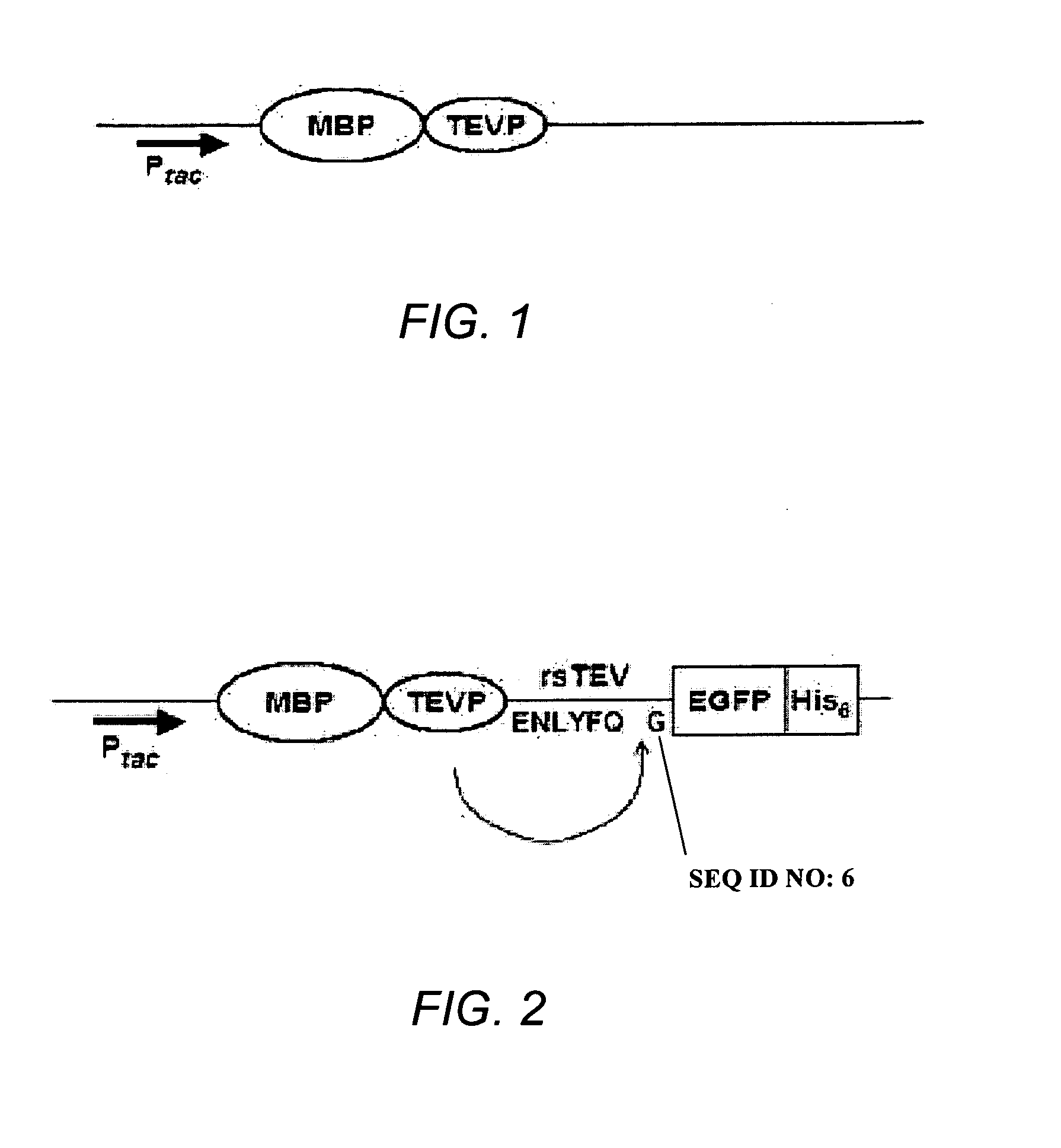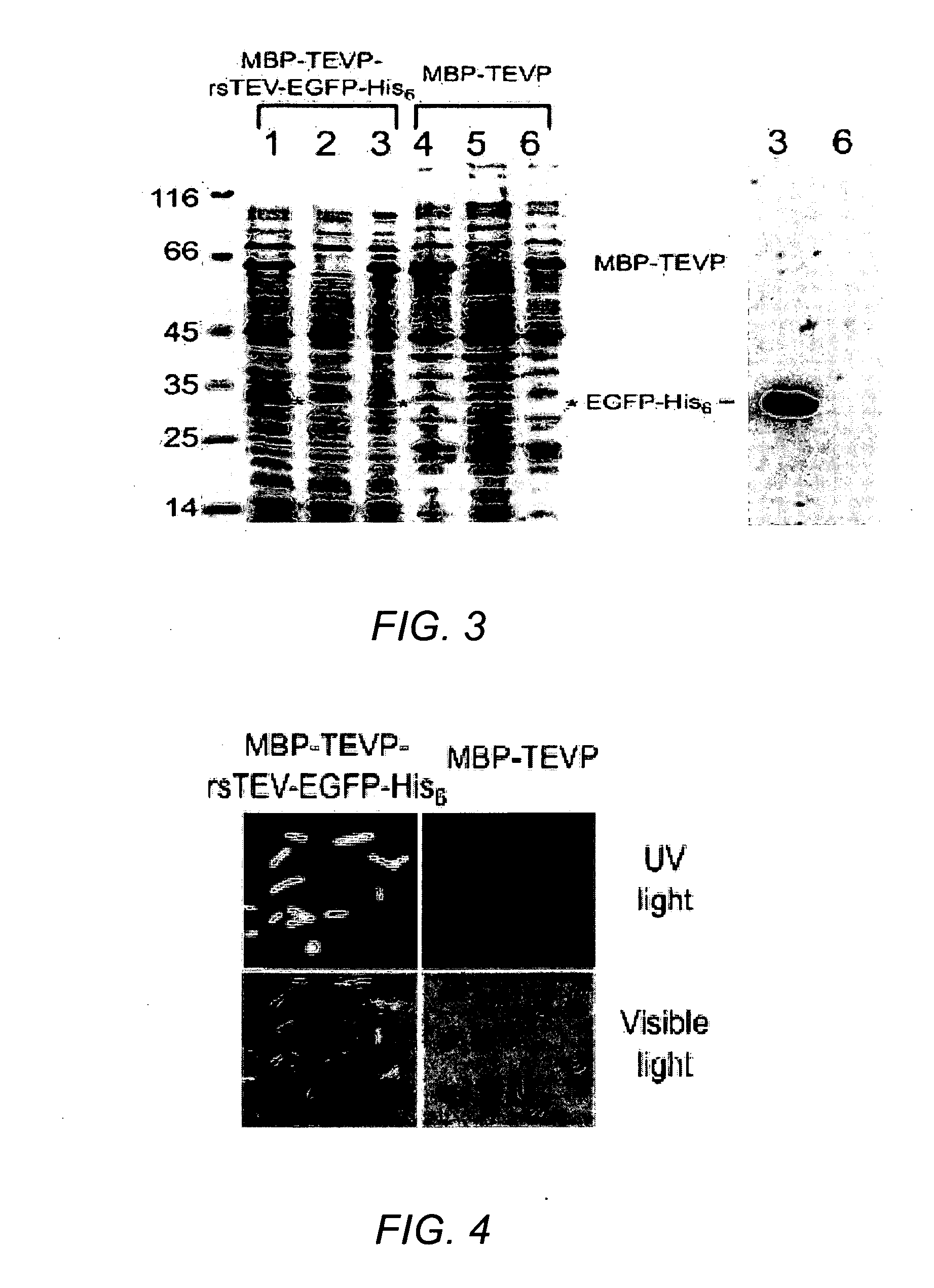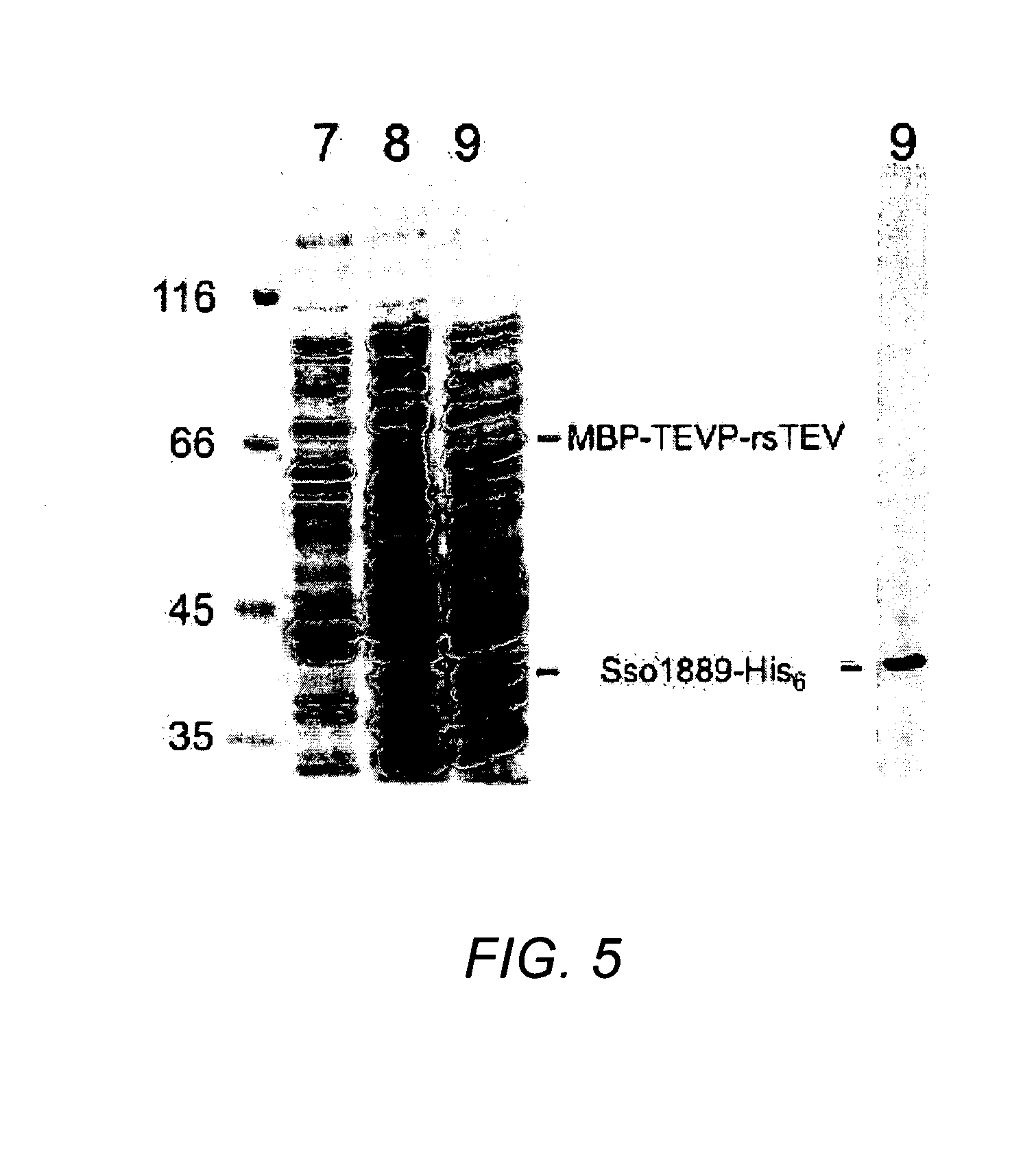Producing a Target Protein Using Intramolecular Cleavage by TEV Protease
a technology of tev protease and target protein, which is applied in the field of protein production, can solve the problems of high cost of certain proteases and the most difficult problems of intracellular processing systems, and achieve the effect of producing the target protein
- Summary
- Abstract
- Description
- Claims
- Application Information
AI Technical Summary
Benefits of technology
Problems solved by technology
Method used
Image
Examples
example 1
Intracellular Processing of MBP-TEVP-RsTEV-GFP-His6 Fusion Protein
[0118]The MBP-TEVP fusion vector schematically shown in FIG. 1 was obtained as described in Shih et al. 2002, and Wang and Wang, 2004.
[0119]The MBP-TEVP fusion vector was further modified to include an MBP-TEVP-rsTEV-EGFP-His6 portion schematically shown in FIG. 2, which is expressed as an MBP-TEVP-rsTEV-EGFP-His6 fusion protein.
[0120]The MBP-TEVP-rsTEV-EGFP-His6 fusion vector was then cloned in E. coli strain JM109(DE3) and the cells induced with 0.1 mM IPTG at 18-20° C. for 24 hr wherein in log phase (OD600˜0.6).
[0121]The cells were then harvested and lysed for protein solubility test as described in Shih et al., 2002, and Wang and Wang, 2004, under low induction temperature and long induction time as defined in the two references to facilitate correct protein folding.
[0122]The cells were then processed wherein to increase the accuracy of solubility testing, an ultracentrifugal force (90,000 g) was applied to elimin...
example 2
Intracellular Processing OF Sso-TEVP-RsTEV-GFP-His6 Fusion Protein
[0131]The experiments described in Example 1 were repeated with the same system described in Example 1 wherein the EGFP protein was replaced by Sulfolobus solfataricus (Sso) 1889 protein.
[0132]Accordingly, in the fusion protein expressed by the corresponding modified expression vector the construct EGFP-His6 was replaced by the construct Sso1889-His6. The fusion protein modified to include Sso1889-His6 was cloned and screened as described in Example 1, wherein the proteins in total cell lysates were separated by SDS-PAGE stained by Coomassie blue and subjected to Western Blotting.
[0133]The results illustrated in FIGS. 5A and B, show that MBP-TEVP-rsTEV-Sso1889-His6 indeed self-cleaved into MBP-TEVP-rsTEV and Sso1889-His6 (FIG. 5A lane 9 and FIG. 5B lane 9). Also, since MBP-TEVP-rsTEV-Sso1889-His6 could not be detected by Western blotting using anti-His6 antibody (FIG. 5B, lane 9), the fusion protein comprising Sso1889...
example 3
Production of Recombinant Proteins with Native or Pre-Selected Amino Acid Sequence
[0135]In one cloning approach an MBP-TEVP-rsTEV fusion protein vector was provided. The MBP-TEVP-rsTEV fusion protein vector was then modified to introduce an SnaBI and XhoI sites.
[0136]A polynucleotide containing the XhoI site and the genetic codons of six Histidine residues were inserted in the pMaI-p2x vector (New England Biolabs, USA) between EcoRI and SalI sites. PmaI-p2x vector expresses a Maltose binding protein (MBP). The resulting vector (pMaI-p2xH) contains the following sequence: 5′ GAATTC [EcoRI]-GGG [Gly]-CTCGAG [XhoI]-(CAC)6 [6xHis]-TAG [stop codon]-GTCGAC [SalI] (SEQ ID NO: 4)
[0137]The TEVP cDNA TEVP was inserted into −p2xH by sticky-end PCR cloning method using the EcoRI site. The EcoRI site (GAATTC) at the 5′-end of TEVP cDNA was mutated to GAATTG, so that this vector only contains one EcoRI site immediately at the 3′-end of TEVP clone.
[0138]A polynucleotide containing rsTEV, including...
PUM
| Property | Measurement | Unit |
|---|---|---|
| solubility | aaaaa | aaaaa |
| Green Fluorescent | aaaaa | aaaaa |
| soluble protein fractions | aaaaa | aaaaa |
Abstract
Description
Claims
Application Information
 Login to View More
Login to View More - R&D
- Intellectual Property
- Life Sciences
- Materials
- Tech Scout
- Unparalleled Data Quality
- Higher Quality Content
- 60% Fewer Hallucinations
Browse by: Latest US Patents, China's latest patents, Technical Efficacy Thesaurus, Application Domain, Technology Topic, Popular Technical Reports.
© 2025 PatSnap. All rights reserved.Legal|Privacy policy|Modern Slavery Act Transparency Statement|Sitemap|About US| Contact US: help@patsnap.com



